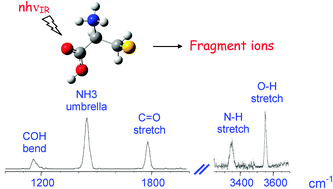Cysteine radical cation: A distonic structure probed by gas phase IR spectroscopy
Abstract
The interest in the radical cations of amino acids is twofold. On the one hand, these species are relevant in enzymatic catalysis and in oxidative damage of

* Corresponding authors
a Laboratoire de Chimie Physique, UMR8000 Université Paris-Sud 11, Faculté des Sciences d’ Orsay, Batiment 350, 91405 Orsay Cedex, France
b Dipartimento di Scienze e Tecnologie Chimiche, Università di Roma “Tor Vergata”, via della Ricerca Scientifica, Roma, Italy
c
Dipartimento di Chimica e Tecnologie del Farmaco, Università di Roma “La Sapienza”, P.le A. Moro 5, Roma, Italy
E-mail:
Simonetta.fornarini@uniroma1.it
Fax: (+39) 06-4991-3602
The interest in the radical cations of amino acids is twofold. On the one hand, these species are relevant in enzymatic catalysis and in oxidative damage of

 Please wait while we load your content...
Something went wrong. Try again?
Please wait while we load your content...
Something went wrong. Try again?
R. K. Sinha, P. Maître, S. Piccirillo, B. Chiavarino, M. E. Crestoni and S. Fornarini, Phys. Chem. Chem. Phys., 2010, 12, 9794 DOI: 10.1039/C003576A
To request permission to reproduce material from this article, please go to the Copyright Clearance Center request page.
If you are an author contributing to an RSC publication, you do not need to request permission provided correct acknowledgement is given.
If you are the author of this article, you do not need to request permission to reproduce figures and diagrams provided correct acknowledgement is given. If you want to reproduce the whole article in a third-party publication (excluding your thesis/dissertation for which permission is not required) please go to the Copyright Clearance Center request page.
Read more about how to correctly acknowledge RSC content.
 Fetching data from CrossRef.
Fetching data from CrossRef.
This may take some time to load.
Loading related content
